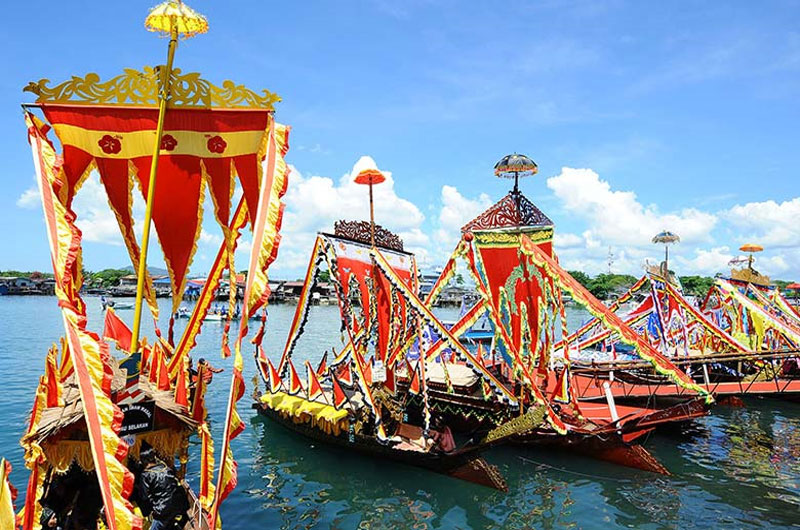
Festivals of Andaman and Nicobar Islands: Celebrating Diversity and Harmony
The festivals of Andaman and Nicobar Islands reflect the cultural diversity, religious harmony, and community spirit of its inhabitants. Each festival, whether religious, cultural, or harvest-related, brings people together in celebration, unity, and mutual respect for traditions.
1. Island Tourism Festival
Time of Festival
- Held annually in December-January.
Specialty of the Festival
- Showcases the cultural diversity of Andaman and Nicobar Islands.
- Features traditional dances (like Nicobari dance), folk music, and art exhibitions.
- Includes water sports, adventure activities, and local cuisine.
Locality of the Festival
- Celebrated across various islands, prominently in Port Blair.
Nature of the Festival
- Cultural and tourism-oriented.
- Emphasis on promoting local culture, adventure tourism, and culinary delights.
- Features cultural performances, exhibitions, sports events, and community interactions.
2. Subhash Mela
Time of Festival
- Celebrated in January, commemorating the birth anniversary of Netaji Subhash Chandra Bose.
Specialty of the Festival
- Pays tribute to the freedom fighter Netaji Subhash Chandra Bose.
- Features processions, cultural programs, and exhibitions on Netaji’s life.
- Includes competitions, debates, and lectures on patriotism and freedom struggle.
Locality of the Festival
- Celebrated in Port Blair, with events at Netaji Stadium and other venues.
Nature of the Festival
- Patriotic and cultural.
- Emphasis on patriotism, freedom struggle, and national unity.
- Features processions, exhibitions, cultural programs, and intellectual discussions.
3. Beach Festival
Time of Festival
- Celebrated in April-May.
Specialty of the Festival
- Focuses on promoting beach tourism and water sports.
- Features beach volleyball, snorkeling, scuba diving, and kayaking competitions.
- Includes cultural performances, seafood festivals, and beachside parties.
Locality of the Festival
- Celebrated on various beaches across Andaman and Nicobar Islands, such as Radhanagar Beach, Corbyn’s Cove Beach, and Neil Island.
Nature of the Festival
- Tourism and recreational.
- Emphasis on adventure sports, marine life, and coastal culture.
- Features sports competitions, cultural shows, culinary delights, and beach festivities.
4. Nicobari Mini Hornbill Festival
Time of Festival
- Celebrated in January-February.
Specialty of the Festival
- Showcases the rich cultural heritage of the Nicobar Islands.
- Features traditional Nicobari dances (like Lava Dance), music, and handicraft exhibitions.
- Includes traditional sports, archery competitions, and local cuisine.
Locality of the Festival
- Celebrated primarily in Car Nicobar and other Nicobar Islands.
Nature of the Festival
- Cultural and community-centric.
- Emphasis on preserving Nicobari traditions, arts, and crafts.
- Features cultural performances, handicraft displays, sports events, and communal feasts.
5. Milad-Un-Nabi
Time of Festival
- Celebrated in the month of Rabi’ al-awwal of the Islamic lunar calendar.
Specialty of the Festival
- Marks the birth anniversary of Prophet Muhammad.
- Includes prayers (Salat), processions (Juloos), and communal meals (Niyaz).
- Features lectures on Prophet’s teachings and spiritual gatherings.
Locality of the Festival
- Celebrated in Muslim-majority areas of Andaman and Nicobar Islands, such as Port Blair and Diglipur.
Nature of the Festival
- Religious and communal.
- Emphasis on spirituality, compassion, and unity.
- Features prayers, processions, communal meals, and spiritual discourses.
6. Pongal
Time of Festival
- Celebrated in January.
Specialty of the Festival
- Marks the Tamil harvest festival, thanking Sun God for agricultural abundance.
- Includes boiling of new rice (Pongal), Kolam (rangoli) decorations, and cattle worship.
- Features cultural programs, traditional dances (like Kolattam), and community feasts.
Locality of the Festival
- Celebrated among Tamil communities in Andaman and Nicobar Islands, such as Port Blair and Havelock Island.
Nature of the Festival
- Cultural and agricultural.
- Emphasis on harvest, gratitude, and community bonding.
- Features rituals, cultural performances, traditional games, and festive foods.
7. Eid-ul-Fitr
Time of Festival
- Celebrated at the end of Ramadan, the Islamic holy month of fasting.
Specialty of the Festival
- Marks the breaking of fast with prayers (Salat al-Eid), charitable giving (Zakat al-Fitr), and feasting.
- Includes wearing new clothes, exchanging gifts, and visiting friends and family.
- Features communal prayers, festive meals (Seviyan), and cultural gatherings.
Locality of the Festival
- Celebrated in Muslim communities across Andaman and Nicobar Islands, including Port Blair and Diglipur.
Nature of the Festival
- Religious and familial.
- Emphasis on faith, charity, and togetherness.
- Features prayers, feasting, gift exchanges, and community solidarity.
8. Christmas
Time of Festival
- Celebrated on 25th December.
Specialty of the Festival
- Commemorates the birth of Jesus Christ with prayers, carols, and Midnight Mass (Christmastide).
- Includes decorating Christmas trees, exchanging gifts, and feasting on traditional delicacies.
- Features cultural programs, Santa Claus appearances, and community service activities.
Locality of the Festival
- Celebrated by Christian communities across Andaman and Nicobar Islands, with prominent celebrations in Port Blair and Car Nicobar.
Nature of the Festival
- Religious and cultural.
- Emphasis on peace, joy, and goodwill.
- Features religious services, festive decorations, carol singing, and communal meals.
9. Mahashivratri
Time of Festival
- Celebrated in February-March.
Specialty of the Festival
- Devoted to Lord Shiva, the Hindu deity of destruction and regeneration.
- Includes fasting (Upvaas), night-long vigil (Jagaran), and offering prayers (Abhishekam).
- Features Rudra Abhishekam, Shiva temples’ visits, and spiritual discourses.
Locality of the Festival
- Celebrated among Hindu communities in Andaman and Nicobar Islands, particularly in Port Blair and Diglipur.
Nature of the Festival
- Religious and spiritual.
- Emphasis on penance, devotion, and Shiva worship.
- Features fasting, prayers, rituals, and spiritual contemplation.
10. Onam
Time of Festival
- Celebrated in August-September.
Specialty of the Festival
- Marks the harvest festival of Kerala.
- Includes floral decorations (Pookalam), traditional dance (Thiruvathira Kali), and boat races (Vallam Kali).
- Features Onam Sadya (feast), cultural programs, and games like Pulikali (tiger dance).
Locality of the Festival
- Celebrated by Malayali communities in Andaman and Nicobar Islands, such as Port Blair.
Nature of the Festival
- Cultural and agricultural.
- Emphasis on harvest thanksgiving, cultural heritage, and unity.
- Features rituals, cultural performances, traditional games, and grand feasts.
